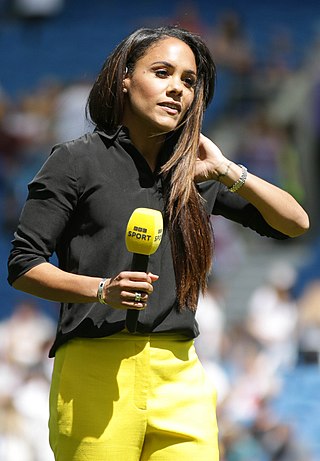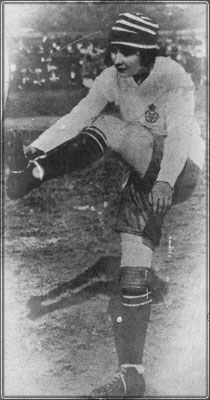
Association football, more commonly known as football or soccer, is a team sport played between two teams of 11 players each who primarily use their feet to propel a ball around a rectangular field called a pitch. The objective of the game is to score more goals than the opposing team by moving the ball beyond the goal line into a rectangular-framed goal defended by the opposing team. Traditionally, the game has been played over two 45-minute halves, for a total match time of 90 minutes. With an estimated 250 million players active in over 200 countries and territories, it is often considered the world's most popular sport.

Women's association football, more commonly known as women's football or women's soccer, is the team sport of association football played by women. It is played at the professional level in multiple countries and 187 national teams participate internationally. The same rules, known as the Laws of the Game, are used for both men's and women's football.

Dame Laura Jane Davies, is an English female professional golfer. She has achieved the status of her nation's most accomplished female golfer of modern times, being the first non-American to finish at the top of the LPGA money list as well as winning the Ladies European Tour (LET) Order of Merit a record seven times: in 1985, 1986, 1992, 1996, 1999, 2004 and 2006.

Women's football has been played in England for over a century, sharing a common history with the men's game in the country in which the Laws of the Game were codified.

Rachel Aba Yankey, OBE is an English former footballer who played for the England national team. She played as a left winger or forward. She left Arsenal after 13 years in December 2016 at the end of her contract. She is ranked among the Arsenal Ladies Legends.

Alexandra Virina Scott is an English sports presenter, pundit, and former professional footballer who mostly played as a right-back for Arsenal in the FA WSL. She made 140 appearances for the England national team and represented Great Britain at the 2012 Summer Olympics.

Emma Anne Byrne is an Irish football goalkeeper who played for the Republic of Ireland women's national football team on a record 134 occasions and served as captain of the team. She spent almost 17 years with Arsenal before joining Brighton & Hove Albion in January 2017.

Lilian Parr was an English professional women's association football player who played as a winger. She is best known for playing for the Dick, Kerr's Ladies team, which was founded in 1917 and based in Preston, Lancashire.

Women's association football in Scotland has an organised history including the first international women's match in 1881, the president of the British Ladies' Football Club in 1895, Lady Florence Dixie, the Edinburgh–Preston "World Championship" in 1937 and 1939, and the Scottish Women's Cup founded in 1970. The sport is jointly overseen by Scottish Women's Football, the Scottish Football Association, and Scottish Professional Football League.
The British Ladies' Football Club was a women's association football team formed in Great Britain in 1895. The team, one of the first women's football clubs, had as its patron Lady Florence Dixie, an aristocrat from Dumfries, and its first captain was Nettie Honeyball.
Sport in Sussex forms an important part of the culture of Sussex. With a centuries-long tradition of sport, Sussex has played a key role in the early development of both cricket and stoolball. Cricket is recognised as having been formed in the Weald and Sussex CCC is England's oldest county cricket club. Slindon Cricket Club dominated the sport for a while in the 18th century. The cricket ground at Arundel Castle traditionally plays host to a Duchess of Norfolk's XI which plays the national test sides touring England. The sport of stoolball is also associated with Sussex, which has a claim to be where the sport originated and certainly where its revival took place in the early 20th century. Sussex is represented in the Premier League by Brighton & Hove Albion and in the Football League by Crawley Town. Brighton has been in the Premier League since 2017 and has been a League member since 1920, whereas Crawley was promoted to the League in 2011. Brighton & Hove Albion W.F.C. play in the FA Women's Super League from 2017. Sussex has had its own football association, since 1882 and its own football league, which has since expanded into Surrey, since 1920. In horse racing, Sussex is home to Goodwood, Fontwell Park, Brighton and Plumpton. The All England Jumping Course show jumping facility at Hickstead is situated 8 miles (13 km) north of Brighton and Hove.
Marie Hourihan is a retired Irish footballer and coach who is currently manager of London Bees. She previously played for clubs including Chelsea, Birmingham City and Manchester City W.F.C. She represented the Republic of Ireland at senior international level, having represented England up to under-23 level.

Emma Clarke was a British footballer, considered to be the first known black women's footballer in Britain.

Helen Matthews, real name probably Helen Matthew, also known by her pseudonym Mrs Graham, was a Scottish footballer, artist, and suffragette. Matthew is known as a leading player and team captain from the 1890s, and for recruiting the first black woman footballer, Emma Clarke.

The 2018–19 FA WSL was the eighth edition of the FA Women's Super League (WSL) since it was formed in 2010. It was the first season after a rebranding of the four highest levels in English women's football. The previous FA WSL 2 became the Championship – eleven clubs competed in the 2018–19 FA Women's Championship.
Celia Brackenridge OBE was a British sportswoman, campaigner and academic. In the mid-1980s, Brackenridge was recognised as the most capped Great Britain lacrosse player. She founded the Women's Sports Foundation UK and also conducted research into the physical and sexual abuse of young sportspeople by coaches.
The English Ladies' Football Association (ELFA) was formed in 1921 and active until 1922. It was arguably a direct response to the Football Association (FA)’s ban on women's football teams. The first meeting of the ELFA was held several weeks after the ban and Leonard Bridgett, the manager and coach of Stoke Ladies, was its first president. Bridgett helped to organise the first and only English Ladies Football Association Challenge Cup competition in the spring of 1922. 24 teams entered the competition and the winners were Stoke Ladies, who beat Doncaster and Bentley Ladies 3–1 on 24 June 1922.
Football in Sussex refers to the sport of association football in relation to its participation and history within Sussex, England. Football is one of the most popular sports in Sussex with over 500 football clubs and 38,000 players in the county.

Florrie Redford was an English footballer and nurse. She played for Dick, Kerr Ladies, one of England's earliest professional women's association football teams. She was a leading goal scorer for the club in 1921, when she scored a total of 170 goals. In later life she worked as a nurse in Canada, returning to the team briefly in 1938.














